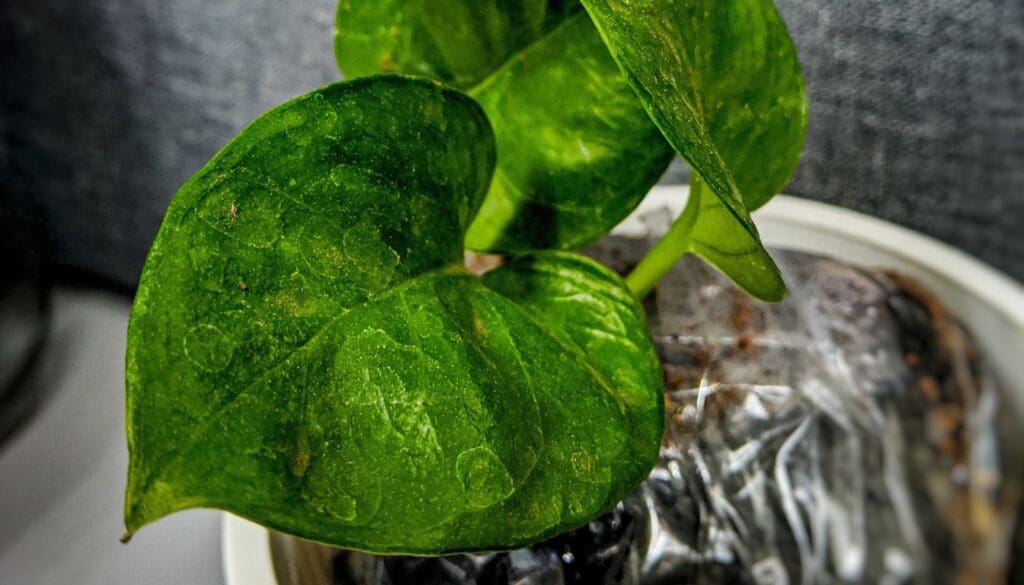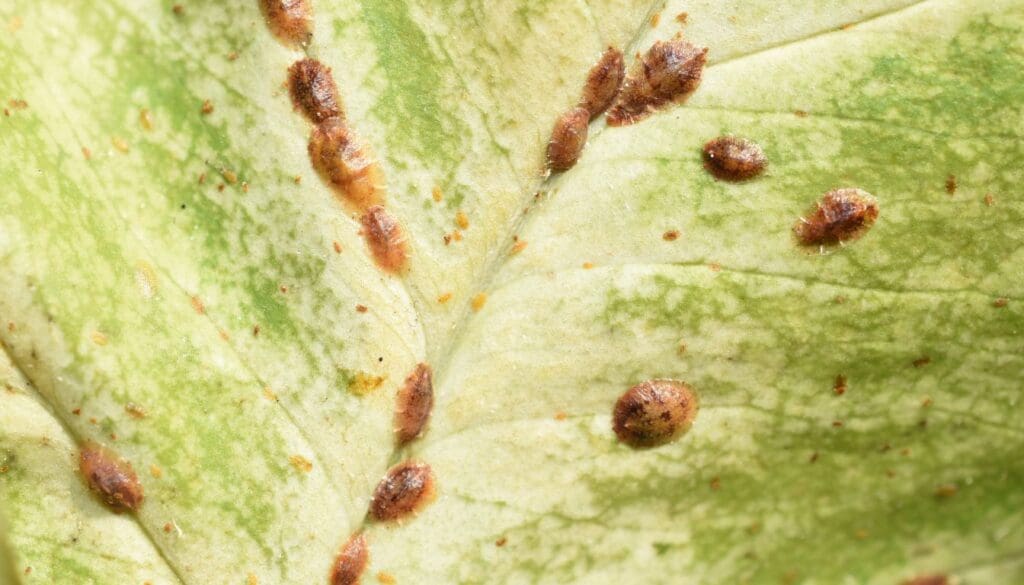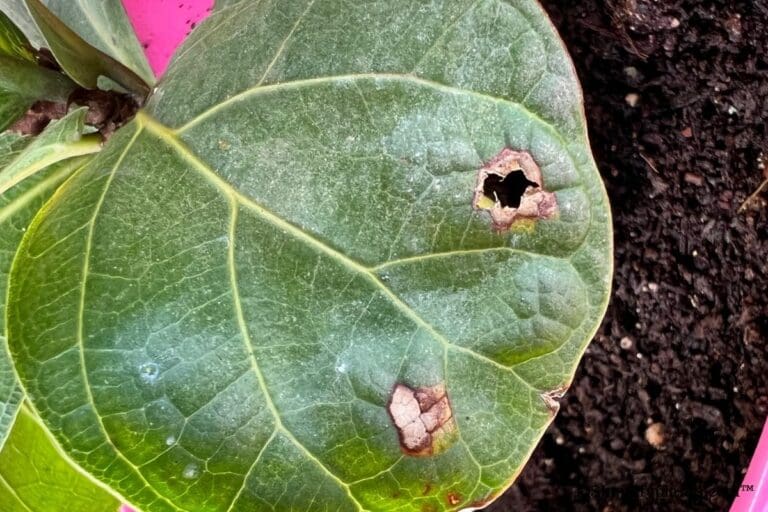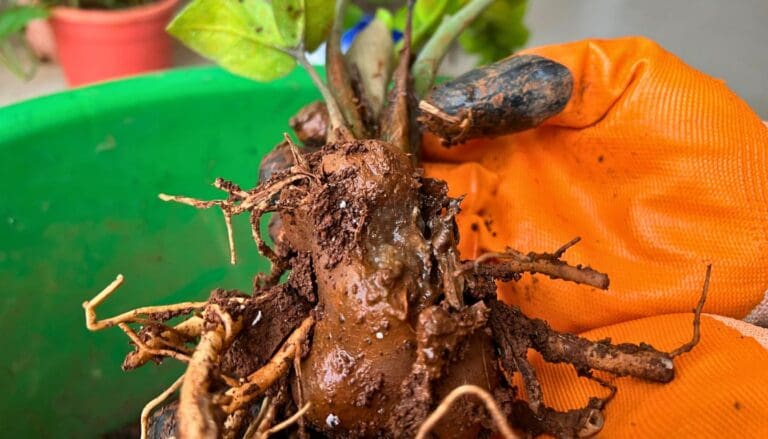Pests Still Infesting Your Pothos? Try This!
Every houseplant enthusiast will have a Pothos plant in their house. But it is sad to see bugs eating your Pothos plant. Fortunately, you can fix the issue if you know why they have targeted your plant.
Healthy pothos don’t attract bugs, but weak pothos do. Common pests include aphids, spider mites, mealybugs, scales, fungus gnats, and whiteflies. Combat them with neem or essential oils, homemade sprays, or natural predators. Use systemic methods and chemical pesticides as a last resort.
Dealing with pests is easy, and there are several methods. But prevention is the best way out. Please read this article until the end to learn why bugs attack your pothos, common pests, ways to eliminate them, and preventive measures.

Please note: Simplify Plants is reader-supported. Some links in the post are affiliate links and I get a commission from purchases made through links in the post.
Do pothos attract bugs?
Healthy Pothos plants are less prone to bug or disease attacks.
Bugs only get attracted to weak and vulnerable plants suffering from excessive moisture, prolonged dry conditions, overfertilization, or lack of good air circulation.
When I discuss Pothos issues with my readers, many ask about common reasons for pest problems.
While pothos can become unhealthy for various reasons, a few common reasons encourage the bugs to reach your unhealthy pothos.
Let’s see Why pothos attract bugs:
Wet conditions from overwatering or poor drainage attract bugs to pothos
Maximum pests thrive best in wet conditions.
The pests have some sixth sense that helps them reach wet conditions, and if your pothos is one such plant, they will reach the plant to lay eggs, multiply, and stay.
Too much moisture makes pothos unhealthy and susceptible to pests like aphids, mealybugs, spider mites, fungus gnats, and scales.
High humidity attracts pests and bugs to pothos.
High humidity escalates dampness, making pothos a perfect place for pests and diseases.
High humidity adds extra moisture to the air.
If your soil is already wet, the high humidity will keep it wet for prolonged periods.
Excessive damp soil with high humidity worsens the condition.
Not only bugs but even fungi are attracted to your pothos.
Overfertilization makes your pothos susceptible to pests
While fertilizing encourages the Pothos plants to grow, overfertilization does more harm than good.
Large amounts of nutrients and salt from the fertilizer cause your pothos to become weaker and grow thin leaves that become more susceptible to pests.
Flushing the soil 2-3 times can remove the fertilizer salts.
Bugs thriving on your pothos due to Poor ventilation
Good ventilation allows the soil to dry faster and keeps the humidity low.
Along with wet conditions and high humidity, lack of proper air circulation will worsen your plant’s condition more.
The spores and bugs will multiply much faster and kill your entire Pothos within no time.
Poor ventilation occurs when too many plants are too close to your pothos or you haven’t pruned your overgrown pothos.
Common bugs in pothos and how to get rid of them
Multiple bugs can attack your pothos. But there are a few common bugs that attack the weak pothos.
Let’s have a look at these common Pothos pests and how to combat them:
1. How to keep Aphids away from your pothos?

Aphids are the most common houseplant bugs, including pothos.
They are tiny, soft-bodied, and pear-shaped bugs with or without wings. They are black, yellow, red, white, and even pink.
These bugs reside under the leaves and on the stems and crawl or fly from one houseplant to another.
Aphids suck the entire sap and dehydrate the plant.
The leaves lose their vigor and color and get wilted, distorted, crinkled, and shriveled.
Aphids release a sticky substance called honeydew, which further causes black mold.
Make an aphid spray by mixing a few tablespoons of pure liquid spar with a small bucket of water. Spray the mixture to the infested area.
Avoid using products containing moisturizers and degreasers.
2. How do you keep Spider mites away from your pothos?
Spider mites are tinier than the aphids.
Hence, infestation can’t be noticed unless you see webbings and tiny white moving dots in your pothos.
Initially, the leaves will have small brown or yellow spots.
Over time, they become yellow as they suck the sap, and then the leaves will wither and fall off.
Wiping off the pothos leaves with a cotton ball dipped in rubbing alcohol can help kill the bugs.
3. How do you keep Mealybugs away from your pothos?

Mealybugs are pink-colored bugs with soft bodies resembling white or gray cottony substances on the underside of pothos leaves.
These sap-sucking bugs love to feed on areas where the leaves meet the stem.
A common sign is a white, cottony substance on the leaves and stems.
Other signs are distorted leaves, stunted growth, sticky leaves due to honeydew extracts, and sooty mold attracting ants.
Over time, the leaves will turn yellow and fall off.
When the bugs reach the soil, white cottony masses emerge from the drainage holes after watering the plant.
Rubbing alcohol can help in killing these bugs.
4. How do you keep Scale insects away from your pothos?

Scale insects are white or brown, and they attach themselves to the leaves and stems of your pothos.
The insects are small, circular, or oval in shape.
They also suck the sap from the leaves and stems and dehydrate the plant.
The bugs mainly target the joints and undersides of the leaves.
Common signs are yellow leaves, stunted growth, leaf and stem dieback, and withered and drooping leaves.
Horticultural oils are the best way to get rid of scale insects.
5. How do you keep Thrips away from your pothos?

Thrips feed on the young and tender leaves and new offshoots of pothos.
The bugs lay eggs on the leaves, and you can barely see them.
Common signs of thrip infestation in pothos are whitish to silvery streaks on the leaves, which turn brown over time.
The leaves become deformed, and brown holes are visible.
Use insecticidal soap solution to control thrips.
Mix 2 tablespoons of insecticidal soap with 1 lit. Water and spray the solution on the affected leaves. The solution will suffocate and kill them.
6. How do you keep Whiteflies away from your pothos?

These sap-sucking bugs are winged bugs with soft bodies and white. Despite their wings, they can’t fly.
Whiteflies suck the vital sap of your Pothos plant and dehydrate it.
You will notice sticky leaves with black mold.
Pothos will have stunted and distorted growth.
The leaves will turn yellow or brown, wilt, wither, and fall off.
Check the underside of the leaves, and you will see their eggs.
Use insecticidal soaps, horticultural oils, or insecticides containing pyrethrins to eliminate whiteflies.
7. How do you keep Fungus gnats away from your pothos?

These white or black opportunistic bugs are slow, flying insects resembling mosquitoes.
Fungus gnats affect your pothos when it is weak and vulnerable.
Healthy plants don’t get affected by them.
The bugs mostly attack the pothos following other infestations like mealybugs, aphids, and spider mites.
You can see them with the naked eye.
Once infected, the gnats target roots, fungus, and other organic matter in the soil.
Pothos will grow poorly, lose vigor, and experience sudden yellowing and wilting.
One of the most effective ways to eliminate gnats is vinegar solution.
Add one cup of vinegar in a shallow saucer, mix 3 drops of liquid dish soap, and keep the saucer near the pothos.
Gnats will be attracted to the solution, leave your pothos, and fly around the saucer.
As they fall on the solution, they will die.
Dealing with bug infestation in Pothos plants
Once you have identified the type of bug infesting your Pothos plant, you must take immediate steps to deal with it.
Here are some steps you can take as soon as you notice the infestation:
- Quarantine your plant immediately and remove the heavily infected leaves.
- Put paper under your plant and shake it to dislodge bugs from their place.
- Knock off the bugs by shaking or showering the pothos.
- Replace the potting soil if the infestation has reached and increased, or add systemic insecticide to the soil.
Besides these steps, you must use homemade sprays, insecticides, or chemical pesticides to eradicate these bugs.
I get many emails and DMs where my readers ask me to share natural and commercial approaches to dealing with bug infestation.
I get requests for the natural methods as there is a lesser risk of chemical contamination.
Below, I have shortlisted the most common and easiest ways to eliminate Pothos pests, both natural and commercial.
11 Natural ways for Pothos bug control
When gardeners are unaware of the natural methods to deal with Pothos pests, they directly buy commercial products.
While chemical pesticides are helpful, they might not be needed for small infestations. Natural procedures should do the work.
Besides, commercial products contain chemicals.
Excessive usage can lead to chemical contamination, further harming pothos.
After some research and personal experience, below, I have shortlisted the best natural methods to control Pothos pests:
1. Natural predators remove the pests from your pothos
Release natural predators like ladybugs, lacewings, and pirate wasps to your Pothos plant.
These insects love munching on pests such as aphids, spider mites, mealybugs, and soft-bodied scales.
As they eat these pests, your plant becomes a bug-free plant without using any chemical products.
2. Neem oil to protect your pothos from pests

Neem oil is a popular horticultural oil for infected plants, including pothos.
If you are a houseplant enthusiast, you must have one of these.
Whenever you find any pest, spray some of it.
You can even spray it as a mist every 15 days to prevent bugs and fungal infections.
Mix two tablespoons of neem oil with one gallon of warm water to make the spray.
Mix it well and spray generously on your plant for a month or two once a week.
Your plant should recover within 10-15 days post-treatment.
However, it will depend on the infestation level.
Use neem oil or any other horticultural oil during the active months.
During winter, use a dormant oil to suffocate the bugs.
3. Chili pepper spray to remove pests from pothos
Blend the chili pepper and make a smooth paste out of it.
Add a non-detergent soap with the mixture and spray it on the infected pothos.
You can also use paprika, ginger, dill, and black pepper instead.
These ingredients work on most pests due to the presence of capsaicin.
4. Wiping the pests off your pothos with Rubbing alcohol
Maximum households will have rubbing alcohol for cleaning purposes. I also have one.
Dip a cotton ball into rubbing alcohol and wipe the infected pothos leaves, focusing under the leaves as most bugs reside.
The alcohol will suffocate the bugs and kill them.
5. Sticky traps to protect your pothos from pests
These traps are sticky cards to trap the flying insects.
Put a few cards around your Pothos plant.
As these bugs fly to reach the plant, they get trapped in the card.
You can also make your trap care by spreading engine oil and petroleum jelly on sticky paper.
6. Botanical oil to eliminate bugs from pothos
Botanical oil sprays are eco-friendly and practical, like neem oil.
These horticultural oils originated from cottonseed, soybean, and mineral oils.
Spray the soil evenly monthly on your pothos until you eliminate the bugs.
Use the oil once a month until all the pests are gone.
7. Removing pests with Essential oil from pothos
Any essential oil will force the pests to leave the Pothos plant.
Effective essential oils are:
- Tea tree
- Peppermint
- Lemongrass
- Eucalyptus
- Lavender
- Rosemary
Add liquid castile soap to the essential oil and apply it to the plant.
8. Use Soap spray to remove pests from pothos

Soap harms soft-bodied Pothos pests like aphids, whiteflies, and scales. It will suffocate and kill them.
Before making the spray, shower your plant to wash off maximum bugs.
Blend 1 tablespoon of non-detergent dish soap with 1 cup of soybean or peanut oil.
Mix the blend with 1 cup of warm water.
Mix the mixture properly and spray on the infected areas.
Let it stay for a while, and then you can wash off the soap.
Do it 1-2 times a week until you eliminate the infestation.
9. Herbal water spray to remove pests from pothos
You will use chili pepper, garlic, and herbs to spray.
All these ingredients are excellent pest repellents.
Their smell will force the pests to leave your pothos, and they won’t return.
Blend chili pepper, garlic, and herbs of your choice, for instance, mint, rosemary, thyme, lavender, sage, or rue.
Add water and liquid castile soap to the blended mixture and spray it on your pothos.
10. Garlic spray to repel insects from pothos
Garlic is a famous insect repellent. Its pungent smell will suffocate the bugs and keep them from reaching your plant further.
Garlic is also known as a natural disinfectant.
To make the spray:
- Take 4 garlic cloves, mince them, and let them sit in one tablespoon of mineral oil for a day.
- Strain and remove the solid garlic matter and mix the oil with a tablespoon of dish soap.
- Add the mixture to the pint of water in a sprayer.
- Spray it to the infected areas.
11. Diatomaceous Earth (DE) to kill bugs on pothos
Diatomaceous earth is packed with fossilized algae that help it become an excellent insecticide.
When bugs with an external waxy coating touch DE, they lose this coating and die from extreme dehydration.
Spread DE around the Pothos stem and soil to set up a perimeter.
You can add some around the rim of your Pothos pot and the leaves.
Homemade insecticide for infected pothos
You can make your homemade pesticide and use it on the infected pothos. Here are two options:
- Mix 1 tablespoon of dish soap and 1-quarter of water. Wipe down all the leaves with it and spray if any thrips are visible.
- Mix 1 teaspoon of cayenne pepper, 1 small onion, 1 tablespoon of non-detergent dish soap, 1 quarter of water, and 1-bulb of garlic. Mix everything well and use it under the leaves.
Commercial products to control Pothos bugs
If the infestation in your pothos is too large, natural methods won’t work as fast as the chemical products.
That’s when you need to choose commercial products containing several chemicals that help kill the bugs:
1. Insecticides containing pyrethrin, pyrethroids, and imidacloprid to control Pothos bugs
Plant-based insecticides containing pyrethrin, pyrethroids, and imidacloprid are ideal for pothos.
The chemicals will paralyze the bugs when they come into contact with the insecticide and then die.
Please read the instructions on the product label and use them carefully to avoid chemical buildup and plant damage.
2. Chemical pesticides to control Pothos bugs

Chemical pesticides and miticides will be the last resort to eliminate Pothos pests.
These products will kill the bugs and control their population faster than the above methods.
These chemical solutions can be toxic to pets and humans.
Keep your pothos out of reach of children and pets.
3. Systemic pesticides to control Pothos bugs
These pesticides are ideal for sap-sucking bugs in your pothos.
These pesticides get absorbed by the plant, and when bugs attempt to suck the sap, they ingest the pesticide and die.
Bug Prevention techniques for Pothos plants
Though you can get rid of the bugs from your Pothos plants, taking steps to prevent these bugs from reaching the plant is essential.
Here are some preventive measures to follow:
Avoid wet or humid conditions
Allow the top 2-4 inches of the potting soil to dry out before you water your pothos. Be careful during the winter, as pothos stay dormant.
As for the humidity, keep it only around 50-60%. Use dehumidifiers or increase airflow to prevent humidity increase.
Improve air circulation
Air circulation helps prevent high humidity, helps the Pothos soil to dry out, and avoids prolonged wet conditions. Here are a few things to do:
- Keep a fan near your plant for good airflow.
- Maintain proper distance if you are keeping too many plants close to each other.
- Prune your Pothos. Excessive overgrowth and too many leaves can reduce adequate airflow between the leaves. Pruning some will increase the airflow.
- Ensure good aeration of the soil so that it dries faster. Make some holes using a fork or a chopstick, avoiding the roots. It’ll also allow the roots to breathe.
Use pasteurized potting mix.
While planting or repotting your pothos, use pasteurized potting mix.
Pasteurization will destroy the harmful organisms in store-bought or garden soil mixes.
Insect eggs, larvae, and fungal spores live in these soil types. Pasteurization will kill them all and make the soil safe to use, thus preventing any infestations.
Final thoughts
Indoor plants are susceptible to pests, but unhealthy plants are more vulnerable. Pothos plants are no exception. Healthy plants never get attracted to bugs, but unhealthy plants do. Wet conditions, high humidity, poor ventilation, and excessive fertilization are common reasons for pest infestation.
Aphids, spider mites, mealy bugs, scale insects, fungus gnats, and thrips are some common Pothos bugs. Once you have identified the issue, isolate your plant, remove the heavily infected leaves, and treat your plant. For small infestations, opt for natural processes like natural predators, neem oil, herbal spray, garlic spray, chili pepper spray, soap spray, diatomaceous earth, rubbing alcohol, and essential oils.
You can also make your homemade insecticides. For extensive infestations, use commercial products with pyrethrin, pyrethroids, and imidacloprid, or systemic insecticides.
How does an unhealthy Pothos look?
An unhealthy Pothos will have discolored leaves, wilting, mushy stems, and stunted growth. Find the actual reason, solve it, and provide adequate care and requirements for faster recovery.
Does pruning help in controlling bugs?
Pothos can outgrow quickly; when it has too many leaves, bugs have better hiding places and more food. Hence, pruning the overgrown leaves does help in controlling bugs.
Reference: Pothos Plant Pests Wikipedia
Recommended Garden Supplies
| Product Image | Our Recommended Gardening Supplies | Check Offers! |
|---|---|---|
Top Top
Top
Top
Top
Top
Top
Top
Top | rePotme Houseplant and Tropical Classic Potting Soil Mix | Check Offer On Amazon |
 Top
Top
Top
Top
Top
Top
Top
Top | Espoma Organic Indoor Plant Food | Check Offer On Amazon |
 Top
Top
Top
Top
Top
Top
Top
Top | GooingTop LED Grow Light 6000K Full Spectrum Clip Plant Growing Lamp | Check Offer On Amazon |
 Top
Top
Top
Top
Top
Top
Top
Top | Soil Moisture Meter | Check Offer On Amazon |
 Top
Top
Top
Top
Top
Top
Top
Top | Govee Hygrometer Thermometer, Bluetooth Enabled! | Check Offer On Amazon |
 Top
Top | LEVOIT Humidifiers for Large Room(Best For Plants) | Check Offer On Amazon |
 Top
Top
Top
Top
Top
Top
Top
Top | Upgraded DIY Automatic Drip Irrigation Kit, 15 Potted Houseplants Support | Check Offer On Amazon |
 Top
Top
Top
Top
Top
Top
Top
Top | Stainless Steel Heavy Duty Gardening Tool Set | Check Offer On Amazon |
 Top
Top
Top
Top
Top
Top
Top
Top | Bonide Insecticidal Soap | Check Offer On Amazon |
 Top
Top
Top
Top
Top
Top
Top
Top | Bonide 32 oz Spray Neem Oil for Organic Gardening | Check Offer On Amazon |
 Top
Top
Top
Top
Top
Top
Top
Top | Garden Safe Fungicide | Check Offer On Amazon |






